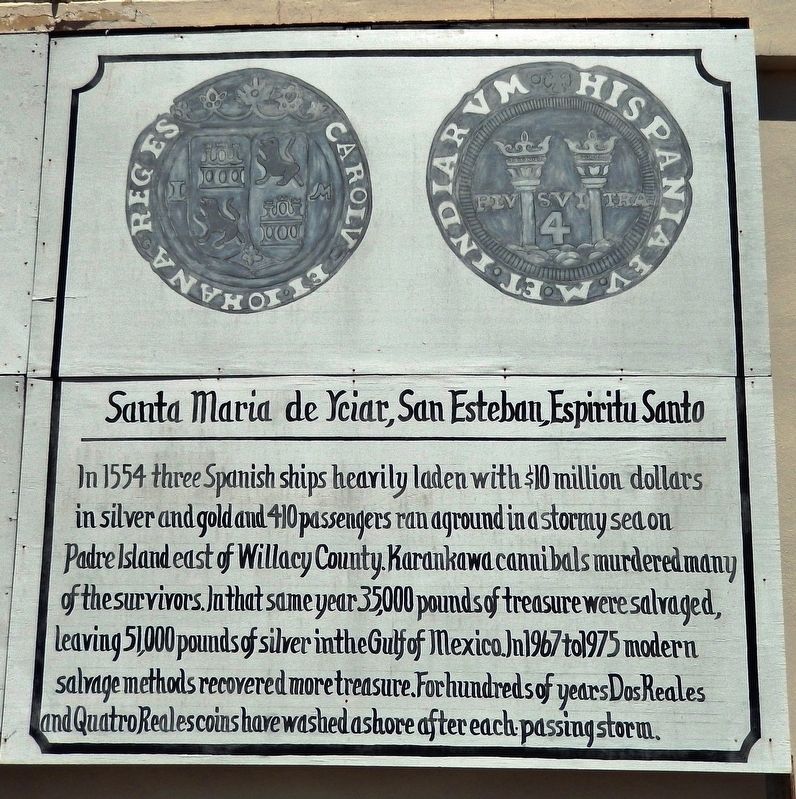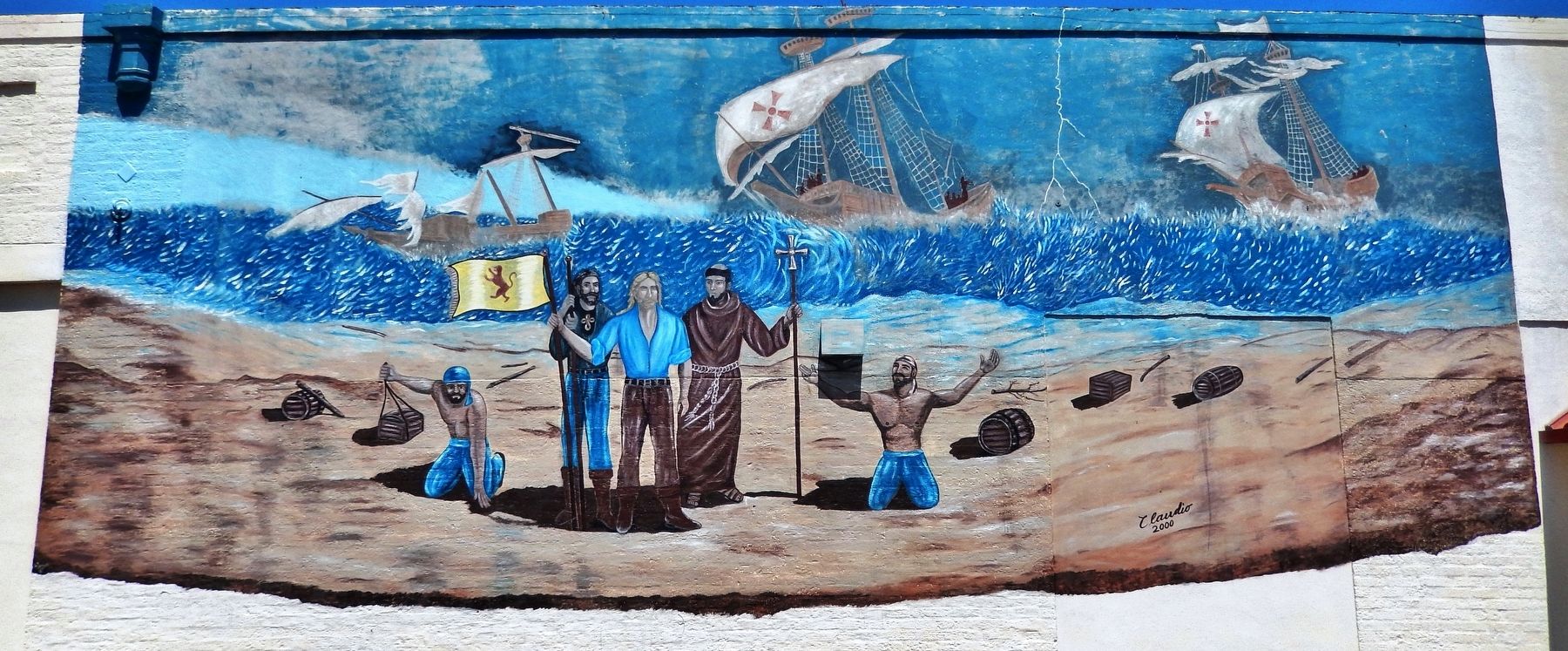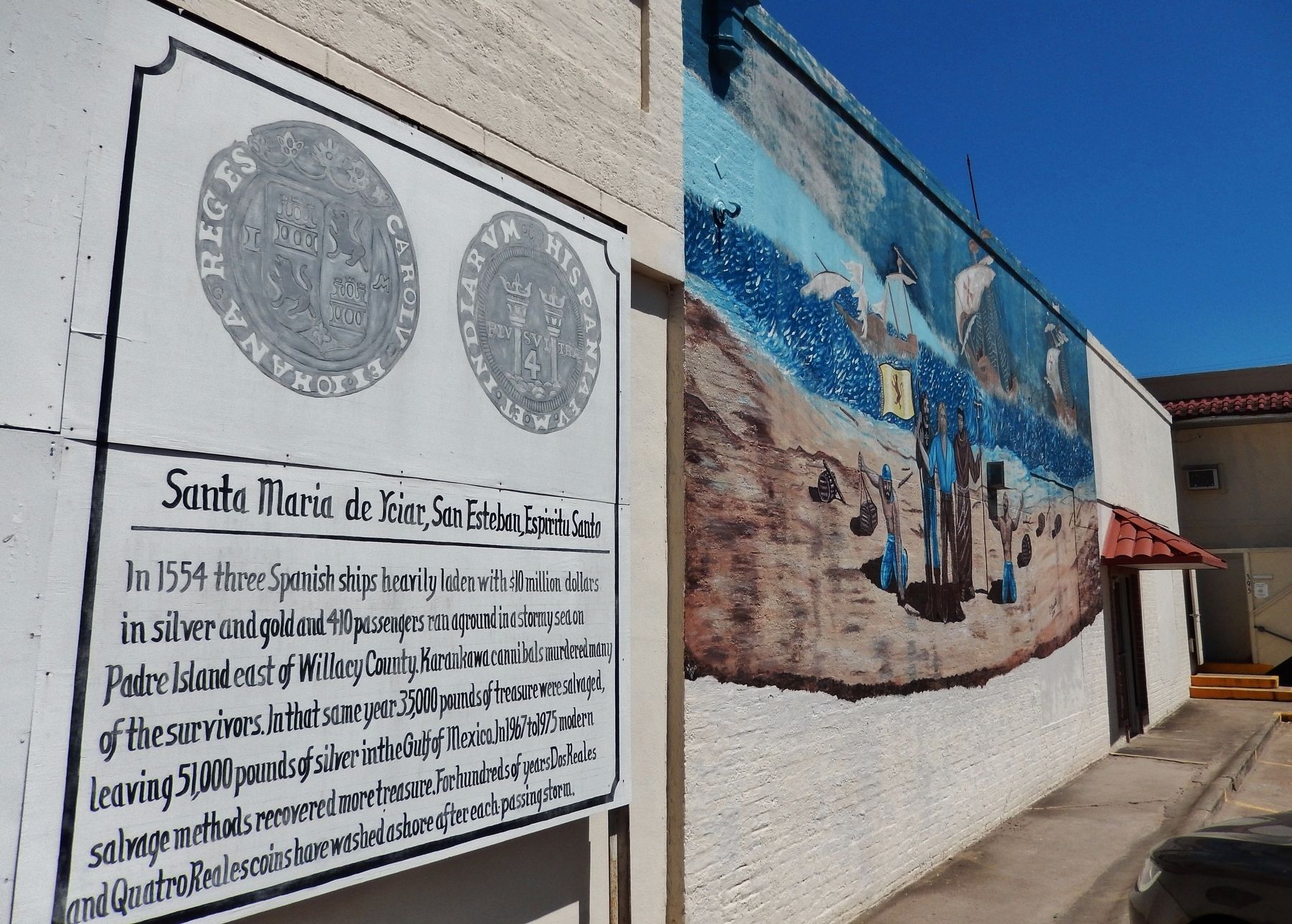Raymondville in Willacy County, Texas — The American South (West South Central)
Santa Maria de Yciar, San Esteban, Espiritu Santu
Inscription.
In 1554 three Spanish ships heavily laden with $10 million dollars in silver and gold and 410 passengers ran aground in a stormy sea on Padre Island east of Willacy County. Karankawa cannibals murdered many of the survivors. In that same year, 35,000 pounds of treasure were salvaged, leaving 51,000 pounds of silver in the Gulf of Mexico. In 1967 to 1975 modern salvage methods recovered more treasure. For hundreds of years Dos Reales and Quatro Reales coins have washed ashore after each passing storm.
Topics. This historical marker is listed in these topic lists: Disasters • Native Americans • Waterways & Vessels. A significant historical date for this entry is April 9, 1554.
Location. 26° 28.904′ N, 97° 47.106′ W. Marker is in Raymondville, Texas, in Willacy County. Marker is at the intersection of West Hidalgo Avenue (State Highway 186) and South 5th Street, on the right when traveling east on West Hidalgo Avenue. Marker and associated mural are mounted/painted on the west wall of the building at this address. Touch for map. Marker is at or near this postal address: 389 W Hidalgo Ave, Raymondville TX 78580, United States of America. Touch for directions.
Other nearby markers. At least 5 other markers are within walking distance of this marker. Raymondville State Bank (about 400 feet away, measured in a direct line); Willacy County Courthouse (about 700 feet away); Willacy County (about 700 feet away); Alejandro G. Trevino (about 700 feet away); Willacy County War Memorial (approx. 0.2 miles away).
Also see . . .
1. The wrecks of Espíritu Santo, Santa María and San Esteban. On April 9, 1554, a treasure fleet consisting of the ships San Andrés, Santa Maria de Yciar, San Esteban, and Espíritu Santo left Veracruz together as a flotilla. Among other things, the ships were transporting circa 91,000 pounds of precious metals belonging to the King of Spain. On April 19, 1554, Santa Maria de Yciar, San Esteban and Espíritu Santo were wrecked off Padre Islands after encountering a sudden storm. Only San Andrés made it through the storm, and eventually entered the harbor of Havana, Cuba with its share of the valuable cargo. (Submitted on May 31, 2018, by Cosmos Mariner of Cape Canaveral, Florida.)
2. The 1554 Wrecks. The ships almost made it to Havana before they were hit by a powerful storm. Only one of the four limped into the harbor at Havana. The other three were blown all the way back across the Gulf of Mexico and on to the beach at Padre Island. After six or seven days, when no help arrived, the remaining survivors decided to walk to Tampico. They believed that it was only a two or three day walk but it was actually almost 400 miles. The survivors dragged their
way down the beach, many were sick and injured, they were short of food and water. After several days, they were approached by a large group of Karankawa Indians.
For days, the Indians pursued the survivors, picking off stragglers, one by one with their bows and arrows. (Submitted on May 31, 2018, by Cosmos Mariner of Cape Canaveral, Florida.)
3. San Esteban (1554 shipwreck). A private company, Platoro, Ltd., began to excavate the Espíritu Santo wreck in late 1967, which caused public outrage and the passage of new laws to protect wrecks on the Texan coast. The remains of San Esteban were found in 1970 and excavated in 1972–73. Many artifacts have been recovered and are held in the Corpus Christi Museum of Science and History. They include the world's oldest mariner's astrolabe with a confirmed date. (Submitted on May 31, 2018, by Cosmos Mariner of Cape Canaveral, Florida.)
Credits. This page was last revised on August 28, 2020. It was originally submitted on May 31, 2018, by Cosmos Mariner of Cape Canaveral, Florida. This page has been viewed 725 times since then and 39 times this year. Photos: 1, 2, 3. submitted on May 31, 2018, by Cosmos Mariner of Cape Canaveral, Florida. • Bernard Fisher was the editor who published this page.


